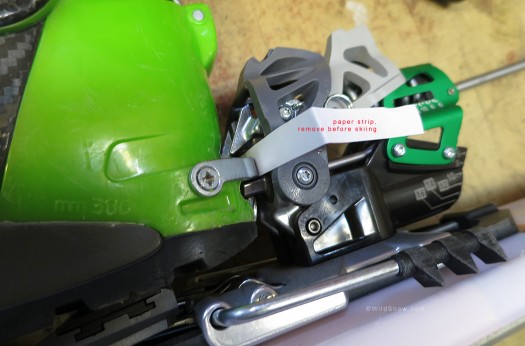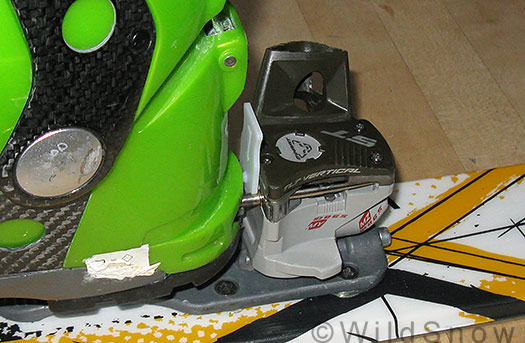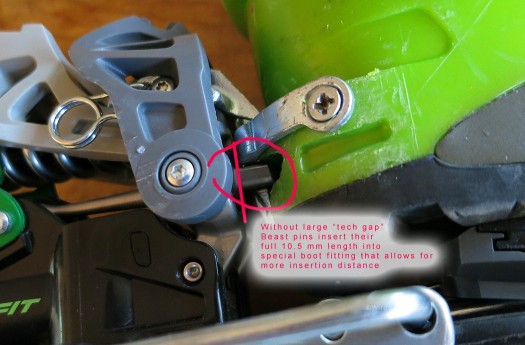One of the coolest features of the Dynafit Beast backcountry skiing binding is the spring-loaded “forward pressure” at the heel, which allows the binding pins to fully insert in the boot heel. This takes the place of the fiddly “tech gap” that all tech bindings have had prior to Beast.
Yes, the gap at the heel of most “classic” tech bindings is one of their more ingenious aspects, as it allows the binding heel pins to slide in and out of the boot heel while the ski flexes. Thus a simple, low tech solution to ski flex compensation. But it is not an ideal system as friction can vary and when the ski is radically flexed the gap may be too large or too small, resulting in the boot ejecting from the binding. Yes, Beast still has to be set for a small gap a the heel, but the way this works is possibly much more reliable than the standard “tech” gap.

Gap between binding and boot heel is set by using the thickness of paper. Thus, Beast heel has no 'forward pressure' while binding is at rest. But when ski is flexed, heel unit is spring loaded and rides for-aft on its base, thus providing pressure when necessary.
No tech gap and spring-loaded heel solve huge issues with tech bindings, namely how the system behaves as the ski flexes. Essentially, when you press your ski into a turn you end up shortening the distance between binding heel and toe units due to the curve of the ski. This phenomenon can easily be observed in the workshop. Just stick a boot in a tech binding, flex the ski, and watch the infamous “tech gap” at the heel open and close. Problems with this are legion.
1.) If the gap of a regular tech binding (not Beast) gets too wide due to reverse flex of the ski, you can pop out in a dreaded pre-release.
2.) If the ski curves during a lateral release and closes the tech gap, the release can jam. Ouch.
3. If the tech gap closes violently during a ski flex it can push the boot out of the binding or damage the binding heel unit, another way a pre-release can occur.
4. This is the sneaky one. If you’re skiing backwards, either doing a falling leaf sideslip or jibbing, when your ski tail impacts something your boot can pop out of the binding like it was never in there. Or say an ice chunk hits the toe of your boot while you’re traveling at speed. Again, you can simulate this in the workshop. With boot in binding on the ski, hold ski vertically with the tail on the floor. Grab a rubber mallet and give the toe a sharp hit front the front. At the correct angle, a moderately sharp blow will pop the boot out of the binding like it was never in there. Scary.

Dynafit 5.5 mm feeler gauge inserted between boot heel and ST model binding. The feeler gauge has been updated for 2013, but is still a fiddle. Beast eliminates need for this wide gap and instead uses paper to set the clearance. Instead of the pins moving in and out of the boot heel as the ski flexes, Beast heel unit is spring loaded on a track, and moves as the ski flexes.

One of the most intelligent differences of Beast over other tech bindings. While heel pins are the same 10.5 mm length as most other tech bindings, combination of Beast boot fitting and heel unit allow pins to insert nearly their FULL 10.5 mm length into the boot socket, thus totally preventing any sort of problems when the ski is over cambered (reverse flexed), which with other tech bindings can cause unintended vertical release of boot from binding.
(Insider info: I’ve seen prototype tech bindings with the heel unit mounted on track, spring loaded, so it functions more like the Beast. This getup adds weight to the standard tech binding, but don’t be surprised if you see some offerings that eliminate the big “tech gap” the same way the Beast does.)
So, are you curious about the almost gone “tech gap” on the Beast Binding? Today we add some notes about forward pressure adjustment and a few other things to our FAQ. Check it.
Beast to be available retail some time in October 2013.
WildSnow.com publisher emeritus and founder Lou (Louis Dawson) has a 50+ years career in climbing, backcountry skiing and ski mountaineering. He was the first person in history to ski down all 54 Colorado 14,000-foot peaks, has authored numerous books about about backcountry skiing, and has skied from the summit of Denali in Alaska, North America’s highest mountain.
